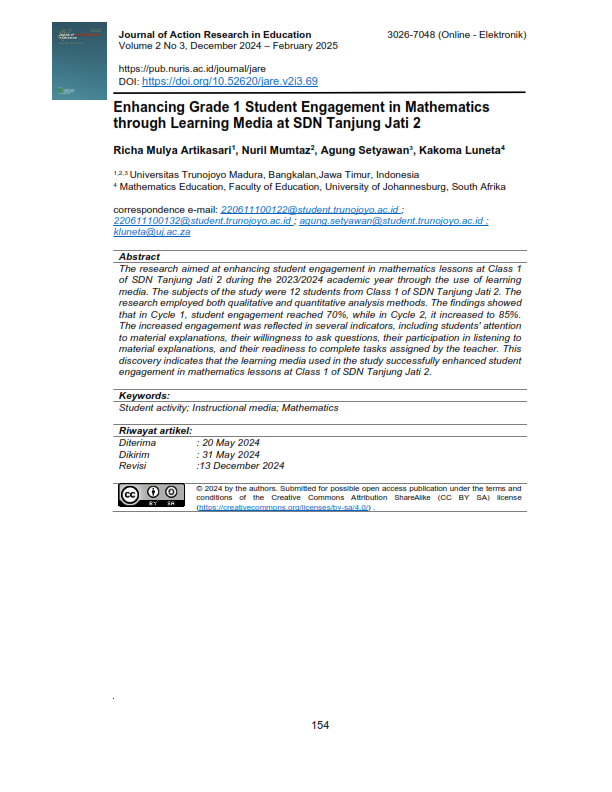Enhancing Grade 1 Student Engagement in Mathematics through Learning Media at SDN Tanjung Jati 2
DOI:
https://doi.org/10.52620/jare.v2i3.69Keywords:
Student activity, Instructional media, MathematicsAbstract
The research aimed at enhancing student engagement in mathematics lessons at Class 1 of SDN Tanjung Jati 2 during the 2023/2024 academic year through the use of learning media. The subjects of the study were 12 students from Class 1 of SDN Tanjung Jati 2. The research employed both qualitative and quantitative analysis methods. The findings showed that in Cycle 1, student engagement reached 70%, while in Cycle 2, it increased to 85%. The increased engagement was reflected in several indicators, including students' attention to material explanations, their willingness to ask questions, their participation in listening to material explanations, and their readiness to complete tasks assigned by the teacher. This discovery indicates that the learning media used in the study successfully enhanced student engagement in mathematics lessons at Class 1 of SDN Tanjung Jati 2.
References
Daniyati, A., Dkk. 2023.Konsep Dasar Media Pembelajaran. Jurnal of Student Research. 1 (1). 284.
Frengky. Model Pembelajaran Matematika Siswa Kelas Satu Sekolah Dasar. Jurnal Psikologi. 35 (2). 152.
George, T. (2023). Mixed Methods Research | Definition, Guide & Examples. Scribbr.https://www.scribbr.com/methodology/mixed-methods-research.
Haylock, D. 2008. Mathematics for primary teachers 3rd Ed. Sage . London.
Haris, D., Putri, R. I. I. 2011. The role of context in third graders’ learning of area measurement. Journal on Mathematics Education 2 55 [12]
Jaelani A, Putri R I I and Hartono Y 2013 Students’ strategies of measuring time using traditional Gasing game in third grade of primary school. Journal on Mathematics Education 4 29 [11]
Kosasih, A, M., Mulyani, S. 2017. Penerapan Model Kooperatif Tipe Team Accelerated Intuction (TAI) untuk Meningkatkan Keaktifan dan Hasil Belajar Peserta Didik Pada Pembelajaran Tematik. Jurnal Pendidikan Guru Sekolah Dasar. 11 (2). 412- 413.
Kumar, R. 2019. Research methodology: a step-by-step guide for beginners. Sage London.
Luneta, K. (Ed) 2013. Teaching Mathematics: Foundation and Intermediate phase. Oxford University Press. Southern Africa:
Meliyawati. 2023. Media Pembelajaran Bahasa. Deepublish.
Putri, N. Y., & Firmansyah, D. 2019. Hubungan Keaktifan Belajar Siswa Terhadap Prestasi Belajar. Prosiding Seminar Nasional Matematikan dan Pendidikan Matematika Sesiomadika.
Prahmana, R. C. I., Helsa, Y., & Dalais, M. 2017. Teachers’ ability in using math learning media. In Journal of Physics: Conference Series (Vol. 943, No. 1, p. 012059). IOP Publishing.
Sukowati. 2023. Meningkatkan Kemampuan Penjumlahan dan Pengurangan Melalui Media Tangga Pintar untuk Sekolah Dasar. Journal of Nusantara Education. 2(2).
Vitasaril, R., Joharman., Suryandari, K. C. 2016. Peningkatan Keaktifan dan Hasil Belajar Matematika Melalui Model Problem Based Learning Siswa Kelas V SD Negeri 5 Kutasari. Jurnal Kalam Cendekia. 4(3).
Yaumi, M. 2017. Ragam Media Pembelajaran : Dari Pemanfaatan Media Sederhana ke Penggunaan Multi Media. Seminar Nasional dan Workshop tentang Pemanfaatan Media Pembelajaran dan Pengembangan Evaluasi Sistem Pembelajaran Berorientasi Multiple Intelligences 30 Desember 2017 PPs STAIN Pare-Pare.
Yanti S, Rif’at M and Suratman D 2015 Pemanfaatan media kit dalam proses pembelajaran matematika di SMP Negeri Kota Pontianak Jurnal Pendidikan dan Pembelajaran 4 5




